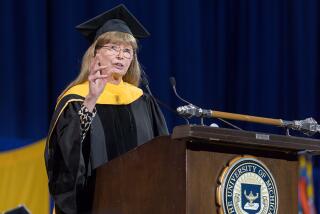The Start of a Love-Hate Affair With a Computer
- Share via
Twenty years ago, I took a job at Information Unlimited Software thinking that I was about to rewrite the manual for its Apple II word processing program. Shortly after signing the requisite nondisclosure agreement, I was led to a secret laboratory.
My boss undid the two locks on the front door, disarmed the security system and escorted me into a crowded and untidy room. On the table was a disassembled computer that didn’t look at all familiar to me.
It was then he told me that it was a prototype of the machine that would rock the computer world--IBM’s first personal computer.
My job was to write the manual for EasyWriter, the word processing program that IBM would make available in August 1981, with its new computer.
That was the beginning of my
long and often tumultuous love-hate relationship with the PC.
Although IBM developed the hardware, all of the software was farmed out to independent companies.
We weren’t required to wear the white shirts and blue ties that had become the uniform for male IBM employees. In fact, the lead programmer for EasyWriter was John Draper (also known as “Cap’n Crunch”), the legendary “phone phreak” who used a whistle from Cap’n Crunch cereal boxes to make free phone calls.
Working with IBM to document an as yet unannounced machine had its challenges. I wrote the manual using my Apple II. Almost every night, I made the 26-mile drive from my Albany, Calif., home to San Francisco International Airport. Because my contact at IBM didn’t have access to a modem, I had to send a copy of that day’s draft manuscript by air freight to IBM’s offices in Boca Raton, Fla.
The development effort went at a frantic pace during the spring and early summer of 1981. I married my wife, Patti, while I was working on the manual and was given one day off for our honeymoon. We were under strict orders to not talk about the project.
One Saturday, an employee from our company was canoeing with a group that included someone from IBM. Our guy said something about working on software for a new computer, which caused the IBM person to call his boss as soon as he got to a pay phone. That Monday, two IBM security people showed up at our door to plumb the leak.
I was under orders to turn over copies of all my drafts, including those that had already been revised. Several months after the PC was announced, I got a call from an IBM executive asking me to account for a page that was missing in one of my early drafts. “But the manual has already been published,” I responded.
“It doesn’t matter,” the executive said. “We need to account for every page of every draft.”
A few months after I finished the IBM manual, I decided to pursue a career in journalism.
I discovered that David Bunnell, who had earlier founded Personal Computing magazine, had recently started a magazine dedicated to the IBM PC.
I wasn’t convinced that a magazine that focused on a single machine was destined to survive, but I signed on anyway.
While I was working at PC, I wrote a story called “PC on a Budget.” There were very few retailers authorized to sell the PC, and none were offering any discounts. A complete system, with 64 kilobytes of memory, two floppy drives, a monochrome display and a dot-matrix printer cost $4,345. I figured out a way to put one together for “only” $3,399 by purchasing a bare-bones 16 KB PC and a monitor from ComputerLand and getting the rest of the parts, a la carte, from various electronics dealers.
I still have that original IBM PC, but aside from the case and the floppy drives, just about everything in it has been replaced. That was the beauty of the PC--it was upgradable and expandable.
This summer also marks my 18th anniversary as a computer columnist for The Times. In July 1983, Richard O’Reilly, who still works for The Times, and I alternated writing “The Computer File,” one of the first PC columns to appear in a major daily paper.
One of the columns I wrote that year focused on the “PC compatible” market that was led by Compaq, which, in January 1983, released a “portable” machine that weighed 28 pounds, was the size of a sewing machine and ran virtually all programs written for the IBM PC. Compaq took advantage of a clause in IBM’s contract with Microsoft that allowed Microsoft to license MS-DOS to other companies.
Some people say IBM made a mistake by allowing Microsoft to license its operating system to other companies. But by creating an open standard, IBM not only launched a PC but also an entire industry and plenty of supplemental industries that employ millions of people around the world.
As a journalist, I treat IBM the same as I do every other PC company but, deep in my heart, I owe “Big Blue” a debt of gratitude not only for helping to jump start my career but for launching a machine, that, truly, changed the world as we know it.
Happy birthday, IBM PC.
*
Technology reports by Lawrence J. Magid can be heard between 2 p.m. and 3 p.m. weekdays on the KNX-AM (1070) Technology Hour.





